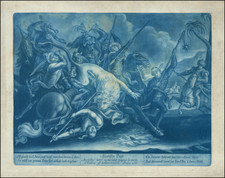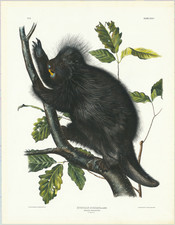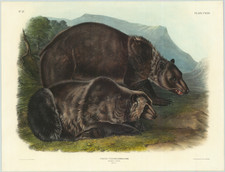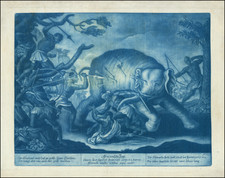A fine example of the Common American Wild Cat a vivid hand-colored imperial folio lithograph of an American bobcat by John James Audubon and J.T. Bowen and published in Philadelphia in 1842.
The precise rendering of the Lynx Rufus at 3/4 natural size demonstrates Audubon’s storied role as America's great 19th-century natural history artist. Set against a backdrop of oaks and rolling fields, the piece harmonizes the subject with its environment, underscoring its ecological context.
The bobcat caries a dramatic expression of surprise, as if the viewer went unnoticed by the animal as it left the undergrowth into a field.
The mid-19th century marked a significant phase in the intersection of art, science, and natural history. Audubon's works, including this distinguished plate from Viviparous Quadrupeds of North America, played a pivotal role in documenting and disseminating knowledge of the continent's diverse wildlife. Amidst burgeoning explorations and discoveries, artworks like these served as both aesthetic and educational resources, contributing to the collective understanding of North America’s ecological wealth.
The Viviparous Quadrupeds of North America: Imperial Folio Edition
John James Audubon, best known for his groundbreaking work The Birds of America, embarked on another ambitious project in the later years of his life: documenting the mammals of North America. This endeavor culminated in the creation of Viviparous Quadrupeds of North America, a substantial and influential work that delved into the diverse world of North American mammals with the same depth and artistry that had made his bird illustrations legendary.
John James Audubon (1785-1851), born Jean-Jacques Rabin in Haiti on April 26, 1785, was a Franco-American ornithologist, naturalist, and painter, celebrated for his detailed illustrations of North American birds in their natural habitats. His major work, a color-plate book titled The Birds of America, is considered one of the finest ornithological works ever produced.
Audubon's early years were shaped by tumultuous events. Born out of wedlock in the French Caribbean colony of Saint-Domingue (now Haiti) to a Creole mother and a French sea captain, he was smuggled to Nantes, France, during a slave rebellion. There, he was adopted by his father and stepmother and raised as their own. His childhood in France was filled with outdoor adventures and initial forays into drawing.
In 1803, to avoid conscription into Napoleon's army, he was sent to America, where he managed one of his father's estates near Philadelphia. This move further kindled his profound interest in the wildlife of the New World. Despite a few failed business ventures and challenges, Audubon remained committed to his passion for nature and art.
His dream to document all of the birds of America began to take form in the 1810s. Travelling through America's wilderness, Audubon observed, hunted, and painted birds. He developed a particular technique that involved wiring freshly killed birds into a natural pose on a board. This innovative method combined with his keen observation allowed him to create more lifelike illustrations than many of his contemporaries.
Failing to secure American subscribers or a publisher for his extensive collection, Audubon traveled to the United Kingdom in 1826. There, The Birds of America was met with critical acclaim. Between 1827 and 1838, this work was published in sections, comprising 435 hand-colored, life-sized prints made from engraved plates.
Audubon followed this success with a companion work, Ornithological Biography, which provided detailed narratives about each species. His later work included studies of American mammals, and he became one of the founding members of the New-York Historical Society.
Despite facing numerous challenges throughout his life, including financial hardships and criticism from some peers, Audubon's dedication to his work resulted in an invaluable contribution to ornithology and American art. He died on January 27, 1851, in New York City. Today, his legacy continues, notably through the National Audubon Society, which promotes conservation and appreciation of birds and their habitats.









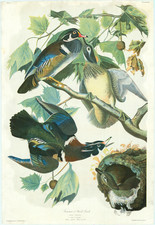
![[ Locomotive ]](https://storage.googleapis.com/raremaps/img/small/85309.jpg)
